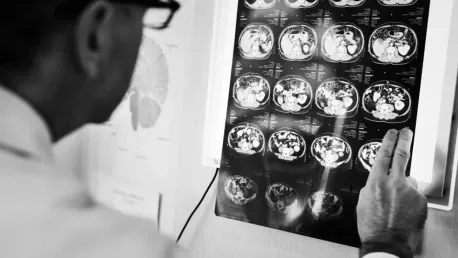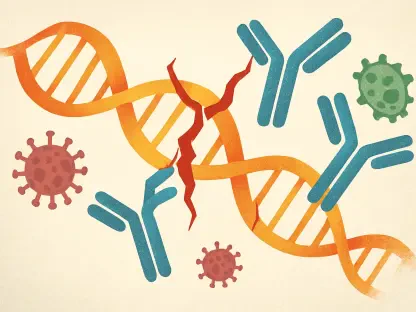The approval of Bluebird bio’s gene therapy, Skysona, in September 2022 by the FDA marked a significant milestone for treating cerebral adrenoleukodystrophy (CALD), a rare and fatal childhood brain disorder. Skysona’s innovation generated hope for families dealing with CALD, yet recent developments have introduced new challenges and concerns. Emerging evidence of blood malignancies among treated patients has sparked a critical reevaluation of the therapy’s safety profile.
The Promise of Skysona
Meeting an Unmet Need
Skysona entered the medical landscape as a beacon for children diagnosed with CALD, an otherwise untreatable disease causing rapid neurological degeneration. Prior to Skysona, treatment options were extremely limited, often resulting in dire prognoses. The gene therapy’s ability to stabilize neurological function in a majority of patients showcased its potential as a transformative treatment. By introducing a new option in the limited arsenal against CALD, Skysona provided a ray of hope where previously there had been none. This was particularly significant for families facing the harsh reality of a disease that rapidly deteriorated their children’s health.
The introduction of Skysona brought with it not just hope but also the promise of a better quality of life. Families who had witnessed the harrowing progression of CALD in loved ones saw the therapy as an opportunity for stability. The success of initial treatments highlighted the potential for recovery or at least mitigation of symptoms, thus offering a tangible improvement in patient outcomes. The excitement in the medical community was palpable, as Skysona appeared to fulfill a desperate need, bringing innovative science into practical, life-changing application.
Mechanism of Action
Skysona employs a lentiviral vector to deliver functional copies of a defective gene into patient stem cells. By correcting genetic mutations responsible for CALD, it essentially halts the disease’s progression. This method, touted for its precision, opened new avenues for treating genetic disorders, promising long-term benefits for affected children. The therapy’s approach involved modifying the patient’s own stem cells, thereby reducing the likelihood of immune rejection—a significant advantage over traditional treatments.
The use of a lentiviral vector to seamlessly integrate into the patient’s genome suggested an elegance in therapeutic design that was both sophisticated and targeted. This approach not only promised to address the root cause of CALD but also provided a framework for treating other genetic conditions in the future. The potential to correct genetic defects at their source was seen as a game-changer in medicine, heralding a new era of precision treatments customized to individual patient needs.
Emerging Cancer Concerns
Recent Findings and Reports
Despite its promising start, Skysona’s journey has been marred by concerning reports of blood cancer development in treated patients. To date, seven cases have been documented among 67 boys enrolled in Skysona studies. These reports include six instances of myelodysplastic syndromes (MDS) and one of acute myeloid leukemia (AML). The emergence of these blood malignancies necessitated a thorough and meticulous reevaluation of Skysona’s safety profile, injecting urgency into ongoing discussions about the therapy’s viability.
The reports of these malignancies have prompted the medical community to delve deep into understanding the causative factors. Such a pivot from celebration to caution was a somber reminder of the inherent risks involved in gene therapy. Researchers are now tasked with dissecting the complexities of the reported cases to discern whether these malignancies were a direct result of Skysona’s mechanism or could be attributed to other contributing factors. This situation has cast a shadow over an otherwise groundbreaking medical achievement, highlighting the critical need for balance between innovation and safety.
Detailed Case Analysis
The troubling pattern emerged from clinical follow-ups where patients exhibited signs of blood cancer post-treatment. The integration of the lentiviral vector into the patient’s genome, potentially disrupting normal gene function, has been identified as a possible catalyst for these malignancies. This integration poses significant safety concerns that have necessitated immediate and extensive scrutiny. Understanding the underlying mechanisms of these cancer cases requires delving into the molecular intricacies of how the lentiviral vector operates within human cells.
Clinical researchers have been meticulous in analyzing the genetic disruptions caused by the vector’s integration. The potential for these genetic modifications to inadvertently activate oncogenes or inactivate tumor suppressor genes necessitates complex analyses and long-term follow-up studies. The focus has shifted to ensuring that therapeutic interventions not only offer immediate benefits but also do not predispose patients to long-term health risks. This nuanced understanding is critical for refining existing treatments and developing safer, more effective gene therapies moving forward.
Balancing Risks and Benefits
Objective Measures of Effectiveness
Skysona’s life-saving potential is undeniable. Clinical trials reported that 30 out of 32 patients maintained stable neurological functions, a testament to the therapy’s efficacy in halting CALD progression. However, this success is now weighed against the substantial risk of developing severe blood disorders. The high efficacy rates initially observed brought immense relief to families and healthcare providers, signaling hope for stabilizing an otherwise volatile condition.
Yet, the revelation of associated cancer risks has added a layer of complexity to patient management and decision-making. These dualities of groundbreaking success and significant risk underscore the necessity of comprehensive risk-benefit analyses in gene therapy. Clinical decision-making has become an exercise in balancing immediate therapeutic benefits with potential long-term adverse outcomes, demanding rigorous evaluation criteria and enhanced patient monitoring protocols.
Expert Opinions
Medical experts, such as Cynthia Dunbar from the National Heart, Lung, and Blood Institute, argue for raising the threshold for administering such therapies. Christine Duncan of Boston Children’s Hospital highlights the essential dialogue between physicians and families, advocating for thorough risk assessment and transparency. These expert opinions emphasize the importance of an informed consent process that thoroughly addresses both the promise and perils of gene therapy.
Dunbar and Duncan underscore the imperative for heightened vigilance and a reevaluation of criteria for patient eligibility, advocating for a more cautious approach in light of the emerging data. Their insights emphasize the need for a collaborative approach in clinical decision-making, involving detailed discussions about the potential outcomes and ensuring that families are well-prepared to tackle the uncertainties that come with pioneering treatments.
Moving Forward with Caution
The Role of Vigilance
Continuous monitoring of patients undergoing gene therapy with Skysona is paramount. Vigilant long-term surveillance can help detect early signs of potential malignancies, allowing for timely intervention. Such measures are advocated to mitigate the risks associated with gene therapy. Regular follow-ups and multi-faceted monitoring protocols can play a crucial role in identifying early biomarkers for blood cancer development, thus enhancing patient safety.
Implementing robust monitoring frameworks is essential to preempt complications and provide immediate care for those developing adverse effects. This proactive approach involves not just regular medical check-ups but also leveraging advancements in genomic and molecular surveillance. By staying ahead of potential risks, healthcare providers aim to balance the lifesaving benefits of Skysona with the highest safety standards.
Future Directions
Researchers are increasingly focused on refining gene therapy techniques to minimize such risks. Emphasis is being placed on understanding whether modifications to the viral vector or alternative methodologies can help in delivering safer treatment options going forward. Exploring different vectors with potentially lower oncogenic risks and refining the integration sites are areas garnering significant attention.
Advancements in gene editing technologies, such as CRISPR, also offer promising alternatives that might circumvent some of the risks associated with viral vectors. By advancing these technologies, researchers hope to achieve the same therapeutic outcomes with enhanced safety profiles. This commitment to constant improvement aims to ensure that the pioneering spirit of gene therapy remains robust while offering safer options for patients.
Broader Implications for Gene Therapy
Developmental Complexities
The Skysona case underscores the intricate nature of gene therapy development. Balancing innovative treatment modalities with patient safety remains a paramount concern. Each new finding contributes to a deeper understanding of how to advance the field responsibly. The complexities involved in predicting long-term outcomes and potential side effects present ongoing challenges that require meticulous research and patient monitoring.
Understanding and mitigating these challenges is key to fostering a sustainable and effective gene therapy ecosystem. The emphasis on robustness in clinical trials and real-world data collection ensures that the lessons learned are translated into safer, more effective treatments. The journey of Skysona serves as both a cautionary tale and a guiding light, highlighting the promise and potential pitfalls of cutting-edge medical innovations.
Policy and Regulation
Regulatory bodies such as the FDA play a crucial role in navigating these complexities. Ensuring rigorous evaluation processes and post-approval monitoring is essential to protect patients while fostering innovation. The Skysona experience may influence future regulatory frameworks and guidelines for gene therapy. These frameworks must remain adaptive, reflecting new scientific insights and emerging data to ensure the highest standards of patient care.
The FDA’s role in balancing regulatory oversight with support for innovation is critical in shaping the future of gene therapy. Ensuring transparent pathways for approvals and rigorous post-market surveillance can drive continued advancements while safeguarding patients’ well-being. This balanced approach is vital for maintaining public trust and ensuring that new therapies meet the highest standards of efficacy and safety.
The Patient and Family Perspective
Informed Decision-Making
Families facing the decision to opt for Skysona must be provided with comprehensive information on both benefits and risks. The uncertainty surrounding long-term outcomes requires that families and physicians engage in well-informed discussions about treatment options. These discussions should include a full disclosure of known risks, the potential for unknown long-term effects, and the current understanding of the therapy’s efficacy.
Providing families with detailed, easily understandable information empowers them to make decisions that align with their values and expectations. The importance of emotional and psychological support during this decision-making process cannot be overstated. Ensuring that families have access to counseling and support mechanisms is crucial to help them navigate the complex landscape of innovative yet risky medical treatments.
Psychological and Emotional Considerations
The decision-making process is deeply personal and fraught with emotional stress. Support systems and counseling are vital components to help families navigate these challenging decisions, ensuring they are not only well-informed but also emotionally supported. The emotional toll of potentially lifesaving yet risky decisions requires a holistic support approach, integrating medical advice with psychological care.
Families grappling with the reality of an aggressive disease like CALD need comprehensive emotional backing. For many, the stakes are incredibly high, and the fear of potential adverse effects can be overwhelming. Emotional resilience and mental health support therefore become integral to patient care, helping families maintain their focus and strength throughout the treatment journey.
Bluebird Bio’s Commitment and Continuing Research
Transparency and Updates
Bluebird bio has committed to keeping patients and the medical community informed about new findings. Transparency regarding ongoing studies and emerging data is crucial for maintaining trust and enabling informed choices. This commitment to openness is fundamental in fostering a collaborative environment where stakeholders can engage in constructive dialogue about the therapy’s future.
Regular updates on clinical outcomes, safety profiles, and research developments are essential components of this transparent approach. Bluebird bio’s proactive communication strategy aims to ensure that all concerned parties have access to the latest information, thereby facilitating shared decision-making processes that are rooted in trust and clarity.
Toward Safer Practices
The FDA’s approval of Bluebird bio’s gene therapy, Skysona, in September 2022, marked a landmark moment in medical treatment for cerebral adrenoleukodystrophy (CALD), a rare, devastating brain disorder in children. This therapy brought incredible hope to families affected by CALD, offering a potential lifeline where previously there had been little chance of effective treatment. Skysona’s arrival heralded a new era in combating this fatal disease, promising to alter the grim prognosis that so many children with CALD and their families face.
However, the initial optimism has recently been tempered by emerging evidence indicating potential risks associated with the treatment. Reports of blood malignancies in patients who underwent Skysona therapy have sparked serious concerns about its long-term safety and effectiveness. This unsettling development has led to a critical reevaluation of the therapy’s overall risk-benefit profile. While Skysona appeared to be a groundbreaking solution to a dire medical problem, these new findings highlight the complexities and uncertainties that accompany pioneering medical treatments. Families and medical professionals are now grappling with these concerns, weighing the hope that Skysona represents against the potential risks it may pose.









